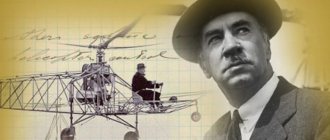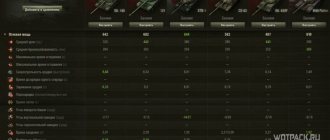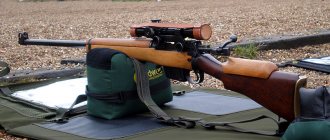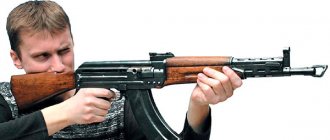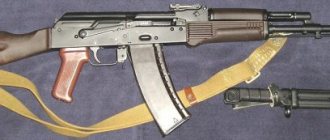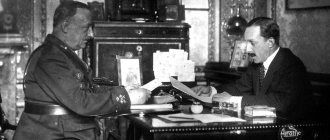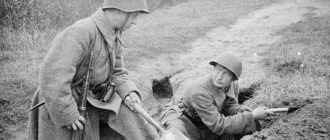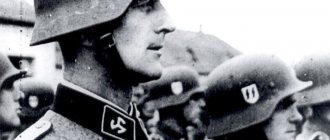Alexey Ivanovich Sudaev - friend and teacher of Kalashnikov
In 1943, the PPS-43, “Sudaev Submachine Gun Model 1943,” was adopted by the Red Army. According to the unanimous opinion of world weapons authorities, this was the best small arms of the Second World War. Little is said or written about him. Everyone knows the legendary PPSh-41, glorified in military novels, films and memoirs, a submachine gun of the Russian genius G.S. Shpagin, who won the competition against V.A. Degtyarev himself.
The PPSh was good for everyone - both in terms of combat accuracy, reliability, and unpretentiousness (with these qualities it was much superior to the German "Schmeissers"), but it was heavy and difficult to manufacture. (True, heaviness was its advantage in hand-to-hand combat.) Therefore, the high Soviet command strongly encouraged and supported the designers in the direction of improving the PP.
Created in 1942, the teaching staff has demonstrated stunning qualities. Superior to the PPSh in combat properties, it was 2.2 kilograms lighter, required 2 times less metal and 3 times less labor costs during production. The machine was put into service under the name PPS-42, and after some modifications - under the final name PPS-43. It served with this name until the end of the war, and until the mid-1950s it was in service with tank crews and paratroopers. In the post-war years, legal (licensed) and illegal versions of PPS were produced in Hungary, Poland, Finland, Korea and even Germany, being standard weapons in the armies of some states until the 1980s.
It was decided to establish production of new machine guns in Leningrad. The supply of weapons there was difficult, and the front required replenishment. From the end of 1942 to June 1943, Alexey Ivanovich worked in the besieged city, helping to establish the production of his brainchild at the factories that remained undestroyed.
Making further improvements to the design of teaching staff, A.I. Sudaev devoted all his efforts to creating a new machine gun chambered for the “intermediate cartridge mod. 1943." The new cartridge of the 7.62 mm caliber, traditional in the Russian army, appeared due to the fact that the rifle cartridge was too powerful for automatic weapons, and the pistol cartridge was too weak.
For this cartridge, Sudaev developed a promising model of the AS-44 and its modifications. He introduced a number of unique innovations into them, which were later successfully used in the design of the most common weapon in the world - the Kalashnikov assault rifle. However, Alexei Ivanovich was not destined to complete the work - on August 17, 1946, he died after a serious long-term illness, a week before his 34th birthday. Gunsmith experts claim that if not for the untimely death of the designer, the “weapon of the 20th century” would not have been the AK, but the AS.
M.T. himself Kalashnikov recalled about him: “Obsession is a quality I would also note in Sudaev’s character. He set a goal for himself and relentlessly walked towards it. Alexey Ivanovich literally caught fire with work, did not like approximateness, uncertainty, and scatteredness. Being a naturally gifted person and already experienced in design, Sudaev generously shared his knowledge with me. I still remember his words: “Keep everything simpler, don’t chase unnecessary originality.” It’s a pity that our creative friendship soon came to an end: the seriously ill Sudaev was taken to one of the Moscow hospitals [Kremlin - author], where he died a few months later in the prime of his creative powers.” We should probably make a small clarification: this, of course, was a creative friendship, but a friendship between teacher and student.
What did this brilliant designer go through in such a short life? He was born on August 23, 1912 in the city of Alatyr, Simbirsk province, in the family of telegraph mechanic Ivan Nilovich Sudaev. In 1929 he graduated from vocational school and went to work as a mechanic. Then he was sent to study at the railway technical school. Working as a technician at the Soyuztransstroy site in the Ural region, he first tried his hand as an inventor, receiving the first copyright certificate No. 42576 for a pneumatic tipper for self-unloading platforms.
At the end of 1934 he was called up to serve in the railway troops. There he received a second copyright certificate No. 35862 for the invention of an anti-theft device (a device that prevented the rolling of a carriage). At the same time, several of his rationalization proposals were introduced into production. Having retired to the reserve, he entered the Gorky Industrial Institute, but devoted all his free time to the study of small arms
Meanwhile, a school of gunsmiths is being created at the Artillery Academy named after F. E. Dzerzhinsky. It recruited students from various universities who had a penchant for invention and design. A young student from Gorky received an invitation, and he was enrolled in the third year of the weapons department. At the academy, he immediately immersed himself in design activities. Less than a year had passed since the academy’s command noted in the performance appraisal Sudaev’s extraordinary design abilities and his penchant for scientific and inventive activities.
One of the founders of the Soviet weapons school, the head of the weapons department of the Art Academy, Lieutenant General, Academician A. Blagonravov, spoke about his student this way: “Even when he was a student at the academy, A.I. Sudaev attracted attention with his extraordinary design abilities. His graduation project [of an automatic pistol] stood out from a number of projects due to the originality of individual mechanisms.”
Having graduated from the academy just before the war and received the rank of military engineer of the 3rd rank, Sudaev was sent to the Small Arms Research Site (NIPSVO). The first practical task: the development of a simplified design of an anti-aircraft gun, the production of which was immediately launched at one of the Moscow enterprises.
At the beginning of the war, the leadership of NIPSVO redirected the young designer to create promising automatic small arms - submachine guns (in modern terms, machine guns).
He learned well the commandments of the old gunsmiths and made the first sample of his machine gun by hand. The rest is known. Alexey Ivanovich was buried at the Vagankovskoye cemetery in Moscow. Whether the memory of him was immortalized in any way, except for a monument on the grave, information could not be found.
Biography[ | ]
Born on August 10 (August 23), 1912 in the city of Alatyr [1].
His father Ivan Nilovich Sudaev, a telegraph mechanic for the postal and telegraph district in Kazan, died in 1924, leaving 12-year-old Alexei and his two sisters dependent on his mother.
In 1929, Sudaev graduated from a vocational school and went to work as a mechanic. After graduating from the Gorky Construction College (industrial transport department) in 1932, he worked at Soyuztransstroy as a site technician in the village of Rudnichnoe, Satkinsky district, Ural region (currently Chelyabinsk region). During this period (1933-1934), his first inventions, “Automatic firing from a machine gun through the action of infrared rays” and “Gasoline meter,” appeared.
In the fall of 1934, Sudaev served in the Red Army, in the railway troops, where he showed great interest in weapons.
Immediately after the army he entered the Gorky Industrial Institute (Nizhny Novgorod State Technical University) where he studied in 1936-1938. During his studies he showed significant creative abilities.
At this time, a school of gunsmiths was created at the Artillery Academy named after F. E. Dzerzhinsky, which recruited students from various universities who had a penchant for invention and design. Lieutenant Sudaev defended his graduation project (7.62 mm light machine gun) with excellent marks, in German. Engineer major.
Excerpt characterizing Sudaev, Alexey Ivanovich
The next day after being admitted to the lodge, Pierre sat at home, reading a book and trying to understand the meaning of the square, which depicted God on one side, moral on the other, physical on the third, and mixed on the fourth. From time to time he looked up from the book and the square and in his imagination made up a new life plan for himself. Yesterday in the box he was told that a rumor about a duel had reached the sovereign's attention, and that it would be more prudent for Pierre to leave St. Petersburg. Pierre intended to go to his southern estates and take care of his peasants there. He was joyfully pondering this new life when Prince Vasily suddenly entered the room. – My friend, what have you done in Moscow? Why did you quarrel with Lelya, mon сher? [my dear?] “You are mistaken,” said Prince Vasily, entering the room. “I found out everything, I can tell you correctly that Helen is innocent before you, like Christ before the Jews.” - Pierre wanted to answer, but he interrupted him. “And why didn’t you address me directly and simply as a friend?” “I know everything, I understand everything,” he said, “you behaved as befits a person who values his honor; It may be too hasty, but we won’t judge that. Just remember the position in which you place her and me in the eyes of the whole society and even the court,” he added, lowering his voice. – She lives in Moscow, you are here. Remember, my dear,” he pulled him down by the hand, “there is one misunderstanding here; I think you feel it yourself. Write a letter with me now, and she will come here, everything will be explained, otherwise I’ll tell you, you can get hurt very easily, my dear. Prince Vasily looked at Pierre impressively. “I know from good sources that the Empress Dowager takes a keen interest in this whole matter.” You know, she is very merciful to Helen. Several times Pierre was going to speak, but on the one hand, Prince Vasily did not allow him to do so, on the other hand, Pierre himself was afraid to start speaking in that tone of decisive refusal and disagreement in which he firmly decided to answer his father-in-law. In addition, the words of the Masonic charter: “be kind and friendly” came to his mind. He winced, blushed, stood up and fell down, working on himself in the most difficult task in his life - to say something unpleasant to a person’s face, to say something that was not what this person, no matter who he was, expected. He was so accustomed to obeying this tone of Prince Vasily’s careless self-confidence that even now he felt that he would not be able to resist it; but he felt that his entire future fate would depend on what he said now: whether he would follow the old, former road, or along that new one, which was so attractively shown to him by the Masons, and on which he firmly believed that will find rebirth to a new life. “Well, my dear,” said Prince Vasily jokingly, “tell me: “yes,” and I will write to her on my own behalf, and we will kill the fat calf.” - But Prince Vasily did not have time to finish his joke, when Pierre, with a fury in his face that reminded him of his father, without looking into the eyes of his interlocutor, said in a whisper: - Prince, I did not invite you to my place, go, please, go! “He jumped up and opened the door for him. “Go,” he repeated, not believing himself and rejoicing at the expression of embarrassment and fear that appeared on Prince Vasily’s face. - What happened to you? You are sick? - Go! – the trembling voice spoke again. And Prince Vasily had to leave without receiving any explanation. A week later, Pierre, having said goodbye to his new friends, the Freemasons, and leaving them large sums of alms, left for his estates. His new brothers gave him letters to Kyiv and Odessa, to the Freemasons there, and promised to write to him and guide him in his new activities. The affair between Pierre and Dolokhov was hushed up, and, despite the sovereign’s then strictness regarding duels, neither both opponents nor their seconds were harmed. But the story of the duel, confirmed by Pierre’s breakup with his wife, became public in society. Pierre, who was looked upon condescendingly and patronizingly when he was an illegitimate son, who was caressed and glorified when he was the best groom of the Russian Empire, after his marriage, when brides and mothers had nothing to expect from him, lost greatly in the opinion of society, especially that he did not know how and did not want to curry public favor. Now he alone was blamed for what had happened, they said that he was a stupid jealous person, subject to the same fits of bloodthirsty rage as his father. And when, after Pierre’s departure, Helen returned to St. Petersburg, she was not only cordially, but with a touch of respect for her misfortune, received by all her acquaintances. When the conversation turned to her husband, Helen adopted a dignified expression, which she, although not understanding its meaning, with her characteristic tact, adopted for herself. This expression said that she decided to endure her misfortune without complaining, and that her husband was a cross sent to her from God. Prince Vasily expressed his opinion more openly. He shrugged his shoulders when the conversation turned to Pierre, and, pointing to his forehead, said: “Un cerveau fele – je le disais toujours.” [Half-crazy - I always said that.] “I said in advance,” Anna Pavlovna said about Pierre, “I said right then, and before everyone else (she insisted on her primacy), that this is a crazy young man, spoiled by the depraved ideas of the century. I said this back then, when everyone admired him and he had just arrived from abroad, and remember, one evening I thought he was some kind of Marat. How did it end? I didn’t want this wedding then and predicted everything that would happen. Anna Pavlovna continued to host such evenings on her free days as before, and those that she alone had the gift of arranging, evenings at which she gathered, firstly, la creme de la veritable bonne societe, la fine fleur de l' essence intellectuelle de la societe de Petersbourg, [the cream of a truly good society, the color of the intellectual essence of St. Petersburg society,] as Anna Pavlovna herself said. In addition to this refined choice of society, Anna Pavlovna’s evenings were also distinguished by the fact that every time at her evening Anna Pavlovna presented her society with some new, interesting face, and that nowhere, as at these evenings, was the degree of the political thermometer expressed so clearly and firmly, on which the mood of the court legitimist St. Petersburg society stood. At the end of 1806, when all the sad details had already been received about Napoleon’s destruction of the Prussian army near Jena and Auerstätt and about the surrender of most of the Prussian fortresses, when our troops had already entered Prussia, and our second war with Napoleon began, Anna Pavlovna gathered at her place evening. La creme de la veritable bonne societe [The cream of real good society] consisted of the charming and unhappy Helene, abandoned by her husband, from MorteMariet, the charming Prince Hippolyte, who had just arrived from Vienna, two diplomats, an aunt, one young man who enjoyed living room with the name simply d'un homme de beaucoup de merite, [a very worthy person], one newly granted maid of honor with his mother and some other less noticeable persons.
Notes
- (now Chuvashia)
- [vpk.name/news/16212_velikii_i_uzhasnyii_avtomat_kalashnikova_priznan_samyim_znachimyim_izobreteniem_hh_veka.html Great and terrible. The Kalashnikov assault rifle is recognized as the most significant invention of the twentieth century] (Russian). Military-industrial complex news (04/25/2008). Retrieved August 13, 2010. [www.webcitation.org/65Aqnqyor Archived from the original on February 3, 2012].
- [world.guns.ru/assault/rus/ak-akm-r.html Modern small arms of the world - AK AKM]
- [m-necropol.narod.ru/sudaev.html Sudaev Alexey Ivanovich (1912-1946)]
Links[ | ]
- RUSSIAN GUNSWORKERS: A life cut short on takeoff
- Designers of small arms: Alexey Ivanovich Sudaev. (unavailable link)
- Birthday of Alexey Ivanovich Sudaev
- The Kalashnikov assault rifle is a symbol of Udmurtia
| Dictionaries and encyclopedias |
|
| In bibliographic catalogs |
|
